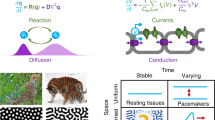Abstract
Julius Bernstein belonged to the Berlin school of “organic physicists” who played a prominent role in creating modern physiology and biophysics during the second half of the nineteenth century. He trained under du Bois-Reymond in Berlin, worked with von Helmholtz in Heidelberg, and finally became Professor of Physiology at the University of Halle. Nowadays his name is primarily associated with two discoveries: (1) The first accurate description of the action potential in 1868. He developed a new instrument, a differential rheotome (= current slicer) that allowed him to resolve the exact time course of electrical activity in nerve and muscle and to measure its conduction velocity. (2) His ‘Membrane Theory of Electrical Potentials’ in biological cells and tissues. This theory, published by Bernstein in 1902, provided the first plausible physico-chemical model of bioelectric events; its fundamental concepts remain valid to this day. Bernstein pursued an intense and long-range program of research in which he achieved a new level of precision and refinement by formulating quantitative theories supported by exact measurements. The innovative design and application of his electromechanical instruments were milestones in the development of biomedical engineering techniques. His seminal work prepared the ground for hypotheses and experiments on the conduction of the nervous impulse and ultimately the transmission of information in the nervous system. Shortly after his retirement, Bernstein (1912) summarized his electrophysiological work and extended his theoretical concepts in a book Elektrobiologie that became a classic in its field. The Bernstein Centers for Computational Neuroscience recently established at several universities in Germany were named to honor the person and his work.
Similar content being viewed by others
References
Bernstein J (1868) Ueber den zeitlichen Verlauf der negativen Schwankung des Nervenstroms. Pflügers Arch 1:173–207
Bernstein J (1871) Untersuchungen über den Erregungsvorgang im Nerven- und Muskelsysteme. Carl Winter’s Universitätsbuchhandlung, Heidelberg
Bernstein J (1894) Lehrbuch der Physiologie des thierischen Organismus, im speciellen des Menschen. Verlag von F. Enke, Stuttgart [later editions 1900 and 1910]
Bernstein J (1902) Untersuchungen zur Thermodynamik der bioelektrischen Ströme. Pflügers Arch 92:521–562 [English translation in: Boylan JW (ed) Founders of experimental physiology. JF Lehmanns Verlag, München 1971, pp 258–299]
Bernstein J (1912) Elektrobiologie. Die Lehre von den elektrischen Vorgängen im Organismus auf moderner Grundlage dargestellt. Vieweg& Sohn, Braunschweig
Grundfest H (1965) Julius Bernstein, Ludimar Hermann and the discovery of the overshoot of the axon spike. Arch Ital Biol 103:483–490
Hodgkin AL, Katz B (1949) The effect of sodium ions on the electrical activity of the giant axon of the squid. J Physiol 108:37–77
Hoff HE, Geddes LA (1957) The rheotome and its prehistory: a study in the historical interrelation of electrophysiology and electromechanics (two parts). Bull Hist Medicine 31:212–234, 327–347
Lenoir T (1987) Models and instruments in the development of electrophysiology, 1845–1912. Hist Stud Phys Biol Sci (HSPS) 17:1–54
Nernst W (1889) Die elektromotorische Wirksamkeit der Ionen. Z phys Chem 4:129–181
Piccolino M (1998) Animal electricity and the birth of electrophysiology: the legacy of Luigi Galvani. Brain Res Bull 46:381–407
Schoeps JH (1992) Bürgerliche Aufklärung und liberales Freiheitsdenken. A. Bernstein in seiner Zeit. (Studien zur Zeitgeschichte Bd. 14). Burg Verlag, Stuttgart Bonn
Schuetze SM (1983) The discovery of the action potential. Trends Neurosci 6:164–168
von Tschermak A (1919) Julius Bernstein’s Lebensarbeit. Zugleich ein Beitrag zur Geschichte der neueren Biophysik. Pflügers Arch 174:1–89
Zett L (1983) J. Bernstein – Leben, Persönlichkeit und wissenschaftliches Werk. In: Zett L, Nilius B (eds) Bernstein-symposium 1981. Beiträge zur Universitätsgeschichte der Martin-Luther-Universität Halle-Wittenberg 32. Halle a. d. Saale, pp 7–22
Author information
Authors and Affiliations
Corresponding author
Rights and permissions
About this article
Cite this article
Seyfarth, EA. Julius Bernstein (1839–1917): pioneer neurobiologist and biophysicist. Biol Cybern 94, 2–8 (2006). https://doi.org/10.1007/s00422-005-0031-y
Received:
Accepted:
Published:
Issue Date:
DOI: https://doi.org/10.1007/s00422-005-0031-y




